
The genus Argiope includes rather large spiders that often have a strikingly coloured abdomen. These spiders are distributed throughout the world. Most countries in tropical or temperate climates host one or more species that are similar in appearance. The etymology of Argiope is from a Latin word argentum meaning silver. The carapace of Argiope species is typically covered in silvery hairs, and when crawling in the sun, they reflect it in a way that gives them a metallic, white appearance.

The family Dipluridae, known as curtain-web spiders are a group of spiders in the infraorder Mygalomorphae, that have two pairs of booklungs, and chelicerae (fangs) that move up and down in a stabbing motion. A number of genera, including that of the Sydney funnel-web spider (Atrax), used to be classified in this family but have now been moved to Atracidae.
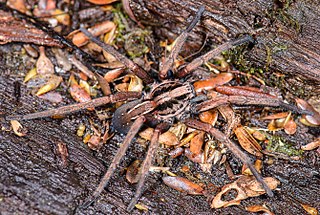
Miturgidae is a family of araneomorph spiders that includes nearly 170 species in 29 genera worldwide. First described by Eugène Simon in 1886, it has been substantially revised, and includes the previous family Zoridae as a synonym, and excludes the family Xenoctenidae. Several genera have also been removed, such as the large genus Cheiracanthium, which was transferred to the Cheiracanthiidae.

Orb-weaver spiders are members of the spider family Araneidae. They are the most common group of builders of spiral wheel-shaped webs often found in gardens, fields, and forests. The English word "orb" can mean "circular", hence the English name of the group. Araneids have eight similar eyes, hairy or spiny legs, and no stridulating organs.

Myrmarachne is a genus of ant-mimicking jumping spiders that was first described by W. S. MacLeay in 1839. They are commonly called ant-mimicking spiders, but they are not the only spiders that have this attribute. The name is a combination of Ancient Greek μύρμηξ, meaning "ant", and ἀράχνη, meaning "spider".

Gasteracantha is a genus of orb-weaver spiders first named by Carl Jakob Sundevall in 1833. Species of the genus are known as spiny-backed orb-weavers, spiny orb-weavers, or spiny spiders. The females of most species are brightly colored with six prominent spines on their broad, hardened, shell-like abdomens. The name Gasteracantha is derived from the Greek gaster (γαστήρ), meaning "belly, abdomen", and akantha (άκανθα), meaning "thorn, spine". Spiny-backed orb-weavers are sometimes colloquially called "crab spiders" because of their shape, but they are not closely related to the true crab spiders. Other colloquial names for certain species include thorn spider, star spider, kite spider, or jewel spider.

Clynotis is a genus of spiders in the family Salticidae, or jumping spiders, contained within the subfamily Marpissinae. They are found across Australia and New Zealand, with some species occupying the Auckland Islands and one found exclusively on Snares Island. There are eight species currently described within the genus, the earliest noted being the type species Clynotis severus, first described in Queensland, New South Wales, Australia in 1879 by Ludwig Carl Christian Koch. The most recent was described in 1931 by Lucien Berland. Two other species previously held within the genus were subsequently reclassified into the genus Tara.
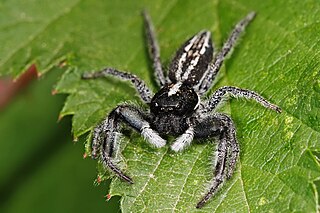
Ocrisiona is a genus of jumping spiders that was first described by Eugène Louis Simon in 1901. O. frenata from Hong Kong belongs to a different, unspecified genus, according to Marek Żabka (1990). Eugene Simon places the genus Ocrisiona close to Holoplatys.

Simaethula is a genus of Australian jumping spiders that was first described by Eugène Louis Simon in 1902. The name is an alteration of Simaetha, a related genus.

Zenodorus is a genus of the jumping spiders distributed from the Moluccas to Australia, including several islands of the Pacific. It was once considered a junior synonym of Omoedus, but this was later rejected by Jerzy Prószyński in 2017. At least one species, Z. orbiculatus, specializes on hunting ants.

Cheiracanthium, commonly called yellow sac spiders, is a genus of araneomorph spiders in the family Cheiracanthiidae, and was first described by Carl Ludwig Koch in 1839. They are usually pale in colour, and have an abdomen that can range from yellow to beige. Both sexes range in size from 5 to 10 millimetres. They are unique among common house spiders because their tarsi do not point either outward, like members of Tegenaria, or inward, like members of Araneus), making them easier to identify.
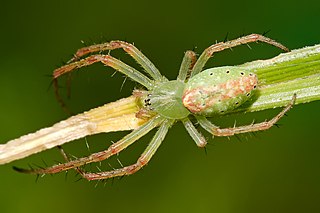
Cyrtophora, the tent-web spiders, is a genus of orb-weaver spiders first described by Eugène Simon in 1895. Although they are in the "orb weaver" family, they do not build orb webs. Their tent-like, highly complex non-sticky web is sometimes considered a precursor of the simplified orb web. These webs are aligned horizontally, with a network of supporting threads above them. These spiders often live in colonies. Females have a body length of mostly about 10 millimetres (0.39 in) long. Some members, including Cyrtophora cicatrosa, exhibit the ability to change colour rapidly.
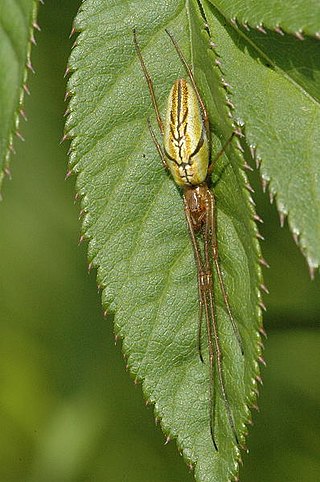
Tetragnatha is a genus of long-jawed orb-weavers found all over the world. It was first described by Pierre André Latreille in 1804, and it contains hundreds of species. Most occur in the tropics and subtropics, and many can run over water. They are commonly called stretch spiders in reference to their elongated body form and their ability to hide on blades of grass or similar elongated substrates by stretching their front legs forward and the others behind them. The name Tetragnatha is derived from Greek, tetra- a numerical prefix referring to four and gnatha meaning "jaw". Evolution to cursorial behavior occurred long ago in a few different species, the most studied being those found on the Hawaiian islands. One of the biggest and most common species is T. extensa, which has a holarctic distribution. It can be found near lakes, river banks or swamps. Large numbers of individuals can often be found in reeds, tall grass, and around minor trees and shrubs.

Bathyphantes is a genus of dwarf spiders that was first described by Anton Menge in 1866.

Arkyidae, also known as triangular spiders, is a family of araneomorph spiders first described by Ludwig Carl Christian Koch in 1872 as a subfamily of Araneidae, and later elevated to a full family in 2017.
Idioctis is a genus of brushed trapdoor spiders that was first described by L. Koch in 1874.
Pungalina is a genus of Australian jumping spiders that was first described by Barry J. Richardson in 2013.
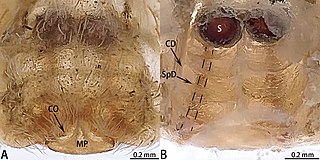
Asianopis is a genus of Asian net-casting spiders first described by Y. J. Lin, L. Shao and A. Hänggi in 2020.















